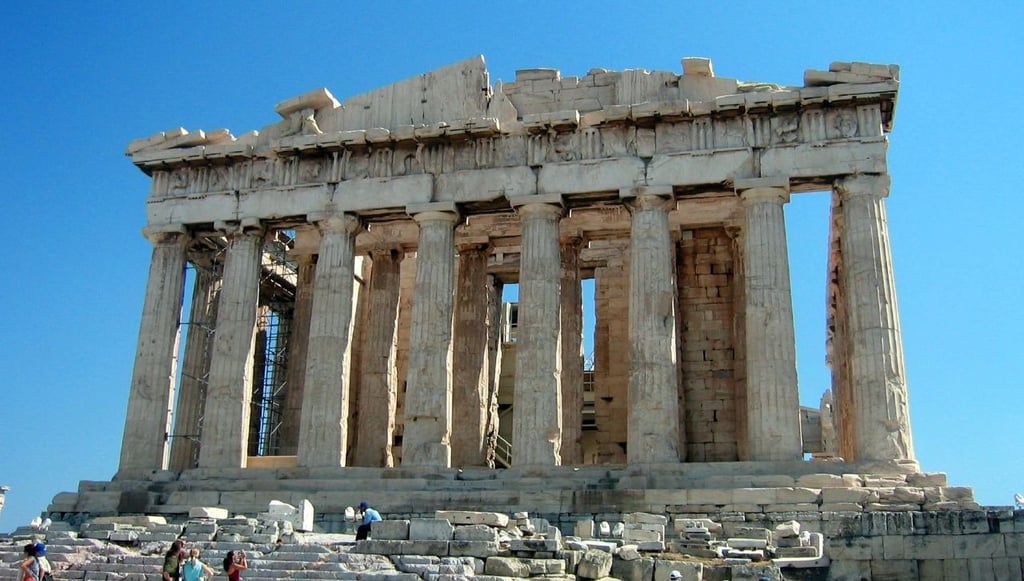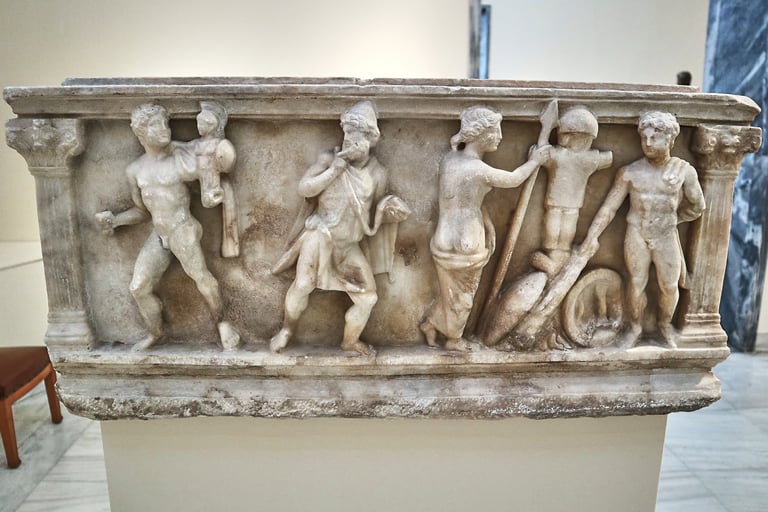Athens – Whispers of the Gods
Step into Athens, where ancient ruins and divine legends echo through timeless streets and sunlit hills.
DESTINATIONS
Jetsclusive
6/27/20255 min read


Athens – Whispers of the Gods
Nestled between hills and sea, Athens pulses with stories as old as time. Walk its sunlit streets, and each stone seems to echo divine whispers. As the cradle of Western civilization, Athens fuses myth, faith, and history at every turn. The gods never left this city, their legends shaping temples, festivals, and daily life. Exploring Athens isn’t just a trip through ruins—it's wandering in a place where ancient gods and heroes still walk beside you.
The Divine Origins of Athens: Myths That Shaped the City
Athens was born from myth, not just mortar and stone. Its stories explain more than origins—they teach justice, unity, and heroic values. The ancient Athenians wove tales into their civic life, making every temple and festival a tribute to the divine.
Athena vs. Poseidon: The Birth of a Sacred City
The city’s name itself speaks to victory and wisdom. Legend tells of a rivalry between Athena, goddess of wisdom, and Poseidon, god of the sea. The two deities competed for the city’s patronage, each aiming to offer a gift. Poseidon struck the ground and created a salty water spring—sign of his oceanic power. Athena followed by planting the world’s first olive tree atop the Acropolis.
This olive tree wasn’t just a plant, it was a promise. It offered oil, wood, and fruit—tools for peace and prosperity. The people chose Athena’s gift, naming their city after her. Over time, this myth shaped Athens’ identity, tying the city to wisdom, artistry, and the peaceful spirit of the olive branch. The story lives on in the city’s coins, art, and the olive trees that still dot the hills.
Erichthonius and the Royal Lineage
Athens’ royal beginnings carry their own mysteries. According to lore, the first Athenian king, Erichthonius, sprang from the earth itself. Athena, striving to help, adopted the infant and shielded him in a chest. He grew to be a wise ruler—so wise that Athenians celebrated him every year during the Panathenaic Festival, weaving his story into parades and ritual games.
His myth blends divine favor and civic pride, reminding Athenians that their leaders came from both earth and goddess. The Panathenaic Festival itself became a city-wide symbol of unity, with citizens from every class joining under Athena’s gaze.
Compare Private Jet Pricing To Athens Here Powered by Villiers Jets — Trusted by 1,000+ flyers worldwide
Theseus and the Foundations of Heroism
No hero captured Athens’ spirit quite like Theseus. He sailed to Crete, defeated the monstrous Minotaur, and saved countless lives. But his journey was much more than a midnight rescue. Theseus unified Attica under Athens, helping transform scattered villages into one strong city-state.
The city honored Theseus as a model of leadership and bravery. Even the Aegean Sea gets its name from his father, Aegeus, who leaped to his death after a tragic misunderstanding. Through this story, Athenians learned about sacrifice, cleverness, and the pain of loss. Geography and poetry combined—every wave seemed to hum the hero’s name.
Sacred Rituals and Living Faith: Religion in Ancient Athens
In ancient Athens, faith meant more than silent prayers. Festivals filled the streets, sacrifices brought neighbors together, and every family felt the gods were close. Religion wasn’t just a choice—it shaped the city’s calendar, its laws, and its social bonds.
The Pantheon of Gods: Power and Personality
Athenians honored dozens of gods, each with their own temples and personalities. At the heart stood Athena, always honored first. Poseidon, her rival, still received sacrifices—especially from sailors and fishermen. Zeus, king of the gods, watched both city and countryside, with giant marble temples raised in his name.
Other deities left marks large and small across the city:
Hephaestus, god of fire and craftsmen, watched over metalworkers.
Dionysus, god of wine and theater, inspired dramatic festivals each spring.
Demeter and Persephone shaped rituals around life, death, and the seasons.
Even lesser-known gods, like the wind deities on the Tower of Winds, found space in Athens’ crowded skyline.
Compare Private Jet Pricing To Athens Here Powered by Villiers Jets — Trusted by 1,000+ flyers worldwide
Rituals, Sacrifices, and Mysteries
Rituals linked every Athenian, young or old, rich or poor. The Panathenaia was the grandest festival, with parades, contests, animal sacrifices, and feasts. A specially woven robe for Athena’s statue capped days of music and games. Another highlight, the Great Dionysia, filled Athens’ theater with plays exploring fate and the flaws of gods and men.
Many rites were public, but some, like the Eleusinian Mysteries, shrouded their secrets. Only the initiated learned Demeter’s promise of rebirth and hope. Such mysteries offered comfort—reminders of cycles, change, and life beyond death.
Women, Priests, and Participation
Religion welcomed everyone, but roles often split along tradition and gender. Men paraded and sacrificed, but women played powerful parts too. Women served as priestesses, especially for Athena and Demeter. They led rituals, chanted hymns, and guarded sacred objects.
Female-focused festivals, like Thesmophoria, let women celebrate and mourn together, strengthening both family and community. In private homes, women tended family shrines, keeping the gods present daily.
Walking Among Legends: Athens’ Mythic Sites Today
Modern Athens is a living time capsule. Its stones, columns, and agoras still whisper myths to anyone willing to pause and listen. To walk here is to walk with legends.
The Acropolis: Echoes of Athena’s Blessing
Atop the Acropolis, the Parthenon commands respect. Built in the 5th century BCE, it stands as both a temple and a monument to Athena’s olive tree. Every carved frieze and marble column recalls ancient stories—each chisel stroke a legend in stone.
Nearby, the Erechtheion marks the mythical contest between gods. Look for the Olive Tree of Athena, honored as the city’s first and most sacred tree. The Caryatids, graceful maidens serving as columns, seem to still watch over the old rituals.
To preserve these wonders, teams of architects and archaeologists work constantly, ensuring the myths won’t fade with the stones.
From the Agora to the Odeon: Living History
Beyond the Acropolis, Athens offers countless sites grounded in myth. The Ancient Agora wasn’t just a market—it was the beating heart of democracy and storytelling. Here, one can visit the Temple of Hephaestus, Greece’s best-preserved ancient temple, covered in mythic scenes of Hercules and Theseus.
The Odeon of Herodes Atticus—still used for concerts—reminds us that art and myth still thrive side by side. Each performance echoes the city’s ancient love for poetry, music, and shared stories.
Cape Sounion and Other Sacred Landscapes
Venture south, and you’ll find the Temple of Poseidon at Cape Sounion perched above the sea. Here, according to myth, Theseus’s father watched for his son’s return. The white-marble columns rise against the blue Aegean, marking the meeting of legend and landscape.
Other hills, like Lycabettus, claim origins in goddess hands. The Philoppapos Hill links to muses and the divine. Each spot carries a myth, tying everyday beauty to immortal tales.
Conclusion
Athens is more than ruins and museums—it's a city where the past stirs in every breeze. Myths carved into stone temples, rituals woven into festivals, and sacred landscapes all remind us: the gods were here. Their stories shaped a city, guided its people, and continue to inspire visitors. If you walk Athens with open eyes, you’ll find it’s not just a city of history, but a living canvas where the whispers of the gods linger.


Luxury
Explore the world of private aviation and travel.
support@jetsclusive.net
© 2025. All rights reserved.
